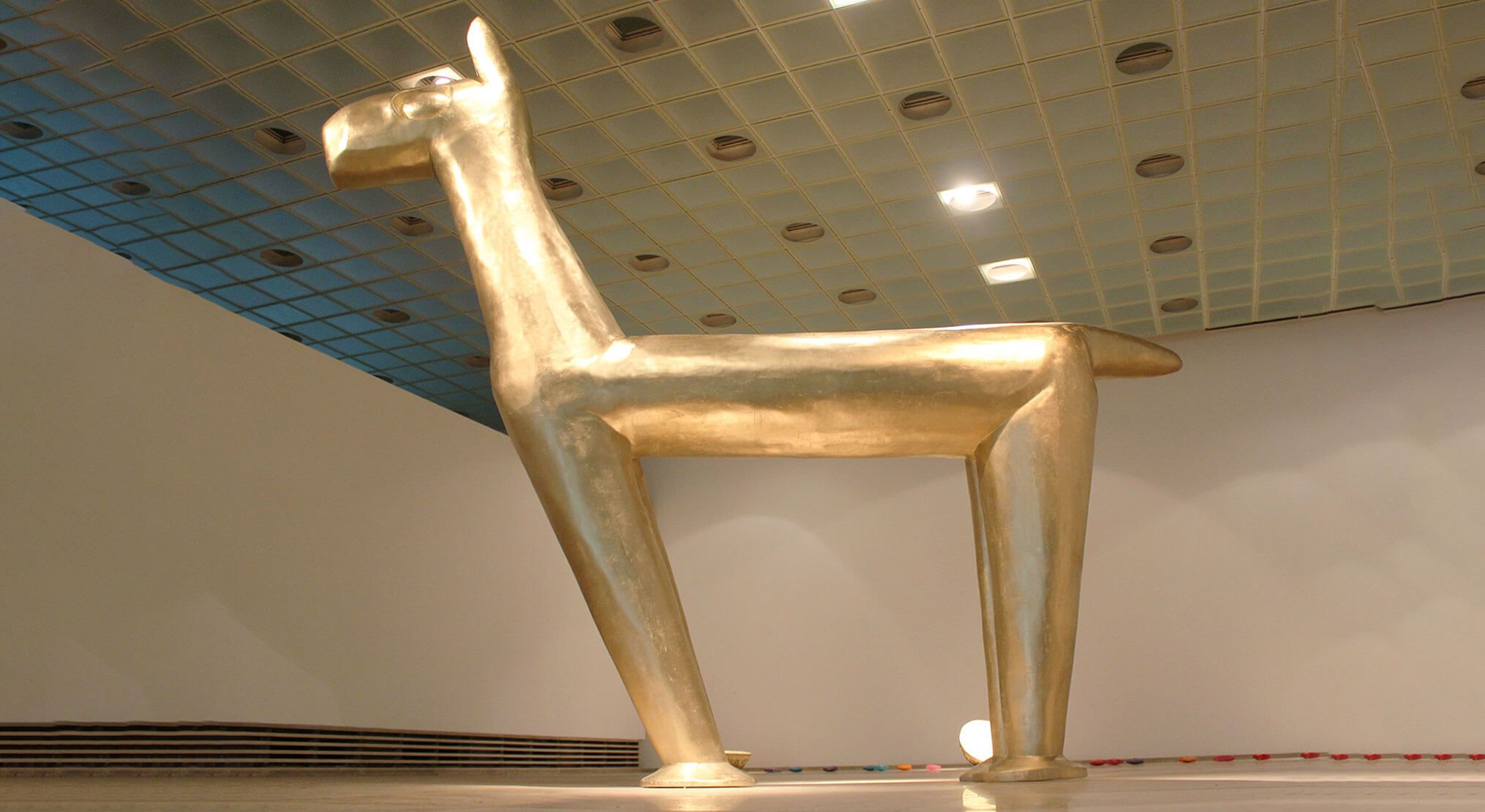
Bernardo Oyarzún, Tentativa, 2016, fiberglass, 330 x 70 x 340 cm. View of the exhibition Mitomanías, Galería Patricia Ready, Santiago, Chile, 2016. Courtesy of the artist
The Poetics of Abya Yala:Towards a Non-Colonial Historyof Contemporary Art
For the Kuna people Abya Yala refers to a land of great vitality, a blooming land. The term has been widely used since the “2nd Continental Summit of Indigenous People and Nationalities from the Abya Yala” as a political leitmotif which refers to the continental land commonly known as America. In putting together scholarly research, artistic knowledge and community experiences, The Poetics of Abya Yala looks at the intricacies of a temporalisation of indigenous art that challenges the teleology of western art history. The panel will explore indigenous creation rooted in material culture; from the complexities of textile traditions to the depths of cosmological abstraction and spirituality, defending Indigenous Contemporary Art as an interruption of Neoliberal multiculturalist desire.
Indigenous Contemporary Art: decolonial discourse and a critique of multiculturalism since Wallmapu
–
Cristian Vargas Paillahueque is a Mapuche art historian, academic and researcher. He has a masters degree in Latin American Studies and is currently a PhD candidate in Latin American Studies at the Universidad de Chile.
He has worked at the Museum of American Popular Art at the University of Chile investigating the Mapuche collection (silverware, textiles, wood and pottery). He has also served as an external researcher at the National Historical Museum of Chile, analyzing Mapuche photographs. He has been a curator together with the artists Sebastián Calfuqueo and Paula Baeza Pailamilla.
His lines of research deal with the relationship between the image and the Mapuche world in various contexts, such as contemporary art, theater, film, and traditional Mapuche art.
Currently, he is conducting research on the notion of Mapuche art in the first half of the 20th century and its links with collecting processes in colonial contexts.
Works
—
Venuca Evanan is an artist and illustrator. She is the daughter of the traditional teacher Primitivo Evanán Poma and the teacher Valeriana Vivanco Espinoza, one of the first painters in the Sarhua community. She specialises in traditional painting styles, using natural colours, raw materials and a quill pen. She has more than seventeen years of experience in painting the renowned Sarhua tables and in experimenting with various two-dimensional formats. In her work, she represents a range of themes including the local customs of the Sarhua people, migration, community legends, the appreciation of the Sarhuina woman in society and her active role in contemporary visual arts. During the last years she has dedicated herself to the promotion and transmission of traditional Sarhua knowledge, in various workshops held in public and private institutions in Lima and in her community. In 2018, she participated in Ceará, a festival in Brazil. In 2019, she participated in an exhibition at the Pensacola Museum, Florida (United States), in addition to obtaining the Kuna Expressions Prize awarded by the Kuna company at the Lima Art Fair. For two consecutive years she has obtained the 3rd place in the Peruvian Birth contest organized by ICTYS. In 2019, she was a finalist in the MUCEN Central Museum contemporary painting contest. In 2020, she created an exhibition at the Yale Sacramental Institute and won first place in the 2020 ICPNA Contemporary Art Prize.
—
Lena Geuer is a research assistant at the Institute of Art and Music at TU Dresden and teaches transcultural art history with a focus on modern and contemporary Latin American art. In her postdoctoral project, she investigates the relationship between art and ecology using aesthetic forms of renunciation. The art scholar completed her doctorate at the Heinrich-Heine University, Düsseldorf within the framework of the Graduate School 'Materiality and Production' on the art of Argentina with a focus on the work of Marta Minujín and Luis Felipe Noé. Lena Geuer will soon publish her monograph on 'arte argentino' as well as the anthology Postcolonialism and Postmigration in collaboration with Ömer Alkin.Tentativa
—
Bernardo Oyarzun was born in 1963 in Los Muermos, Chile. He lives and works in Colicheu, locality of the municipality of Cabrero in the Biobío region, Chile. Bernardo Oyarzún’s work is inserted in a proletarian context, its references are taken from the marginal sectors of society and have an anthropological foundation that is associated with Latin American identity, its native roots and mestizaje. He combines anthropological, social, historical, and ethnic elements in order to present, in a critical way, Chilean culture and society. For his installations, he commonly uses documents and photographs of his personal history and origins, which are linked to the native forests of southern Chile and Mapuche culture, indigenous inhabitants of south-central Chile and southwestern Argentina. His breakthrough was ‘Bajo Sospecha’ (‘Under Suspicion’, 1998), an exhibition inspired by a past event where he was arrested by Chilean police after being confused with a criminal. Oyarzún has exhibited at 18 solo shows in Chile and abroad, as well as 30 international exhibitions and biennales.
—
Following an MA in Photography at the UAL in 2016, Brenda Vega was awarded the Troika Award for Photography with the multimedia installation ‘Interfaced Nature’, with which she graduated from the Masters. She has since completed residencies at No Lugar - Ecuador, Lumen in London, SIM in Iceland, and has exhibited in solo and group shows in Chicago, London, Falmouth, Hangzhou, Tel Aviv, Madrid, Bogotá, Lima, Atina, Reykjavik, Quito and Guayaquil. Brenda is an Art and Photography Teacher at the College of Communication and Contemporary Arts of the Universidad San Francisco de Quito. She is also currently a Doctoral Candidate in Critical Theory at 17 Instituto de Estudios, Mexico.